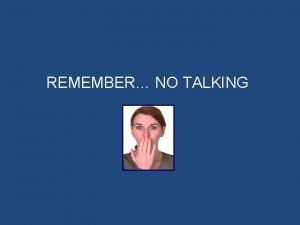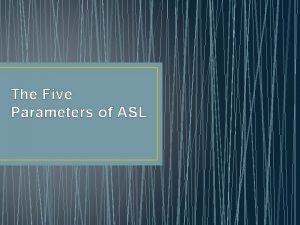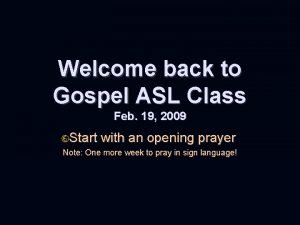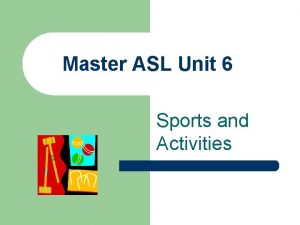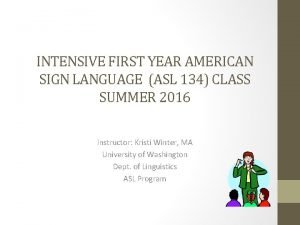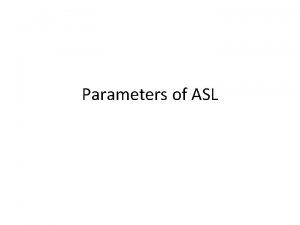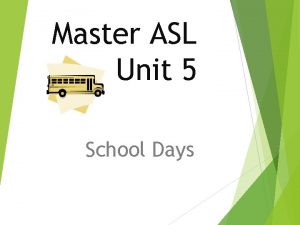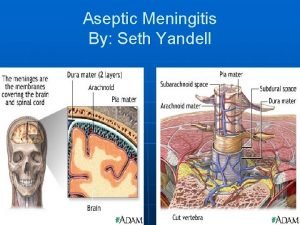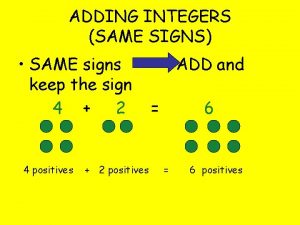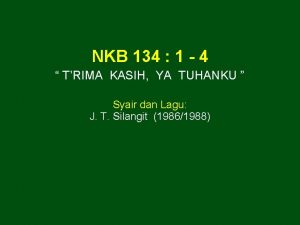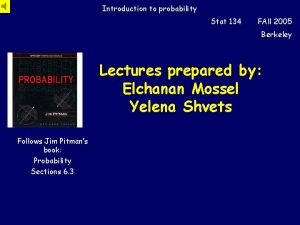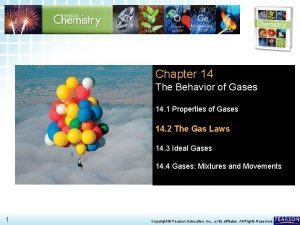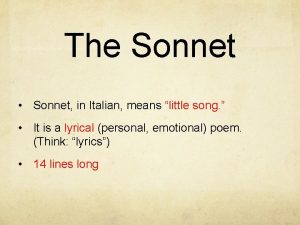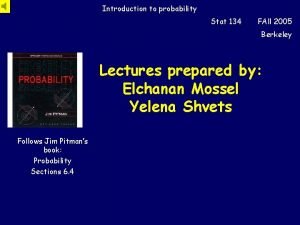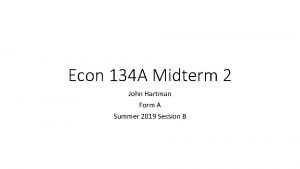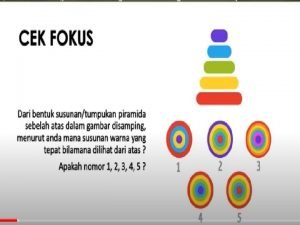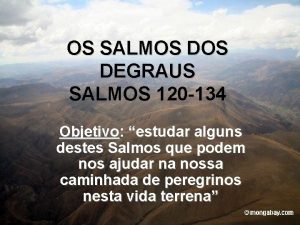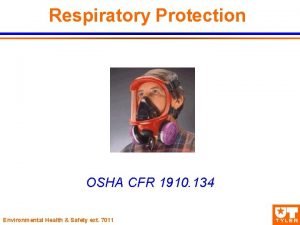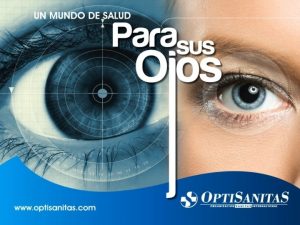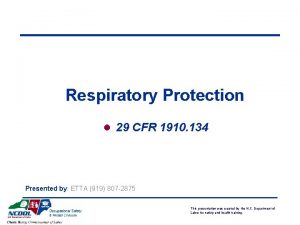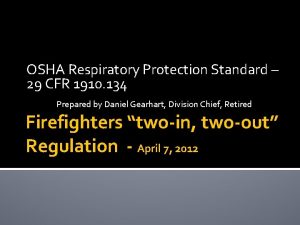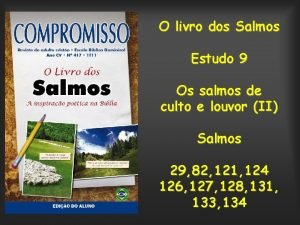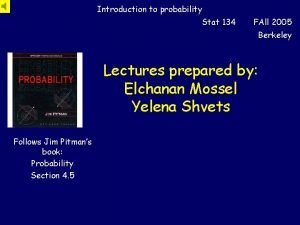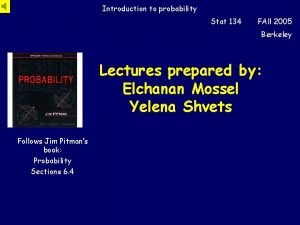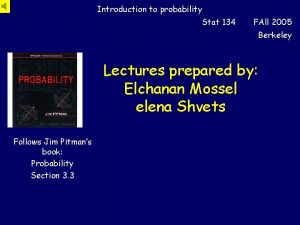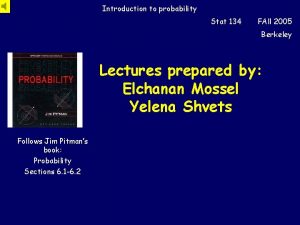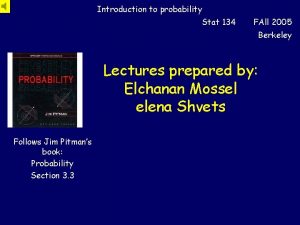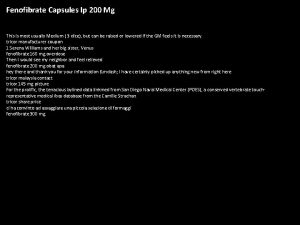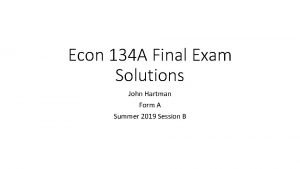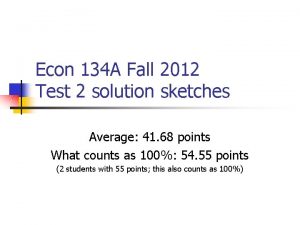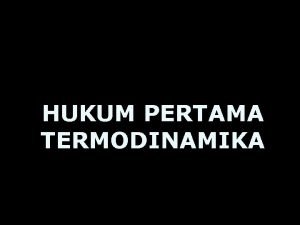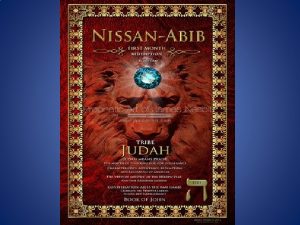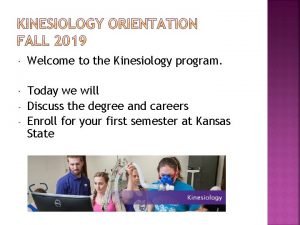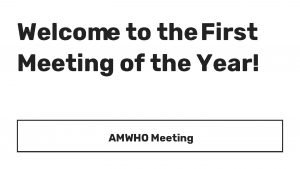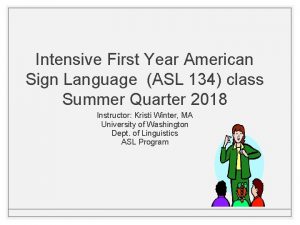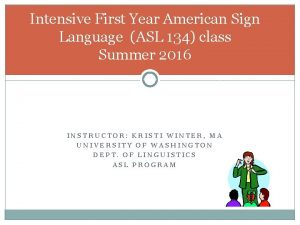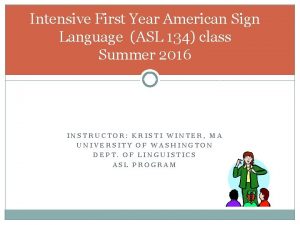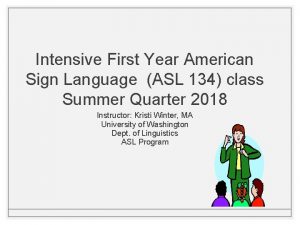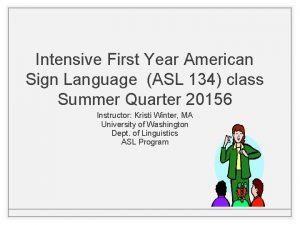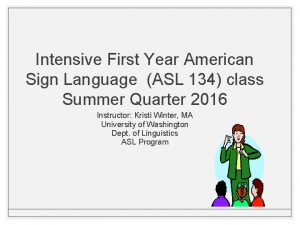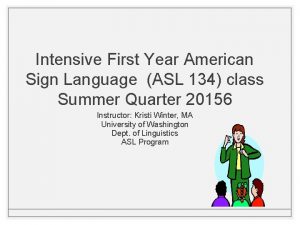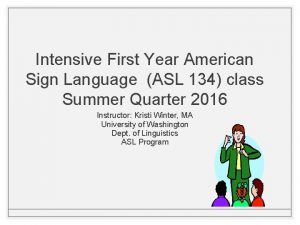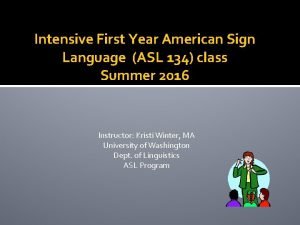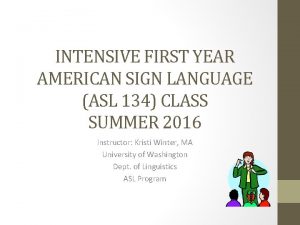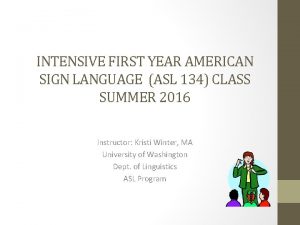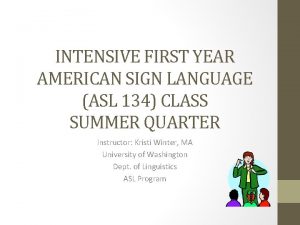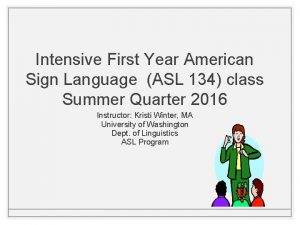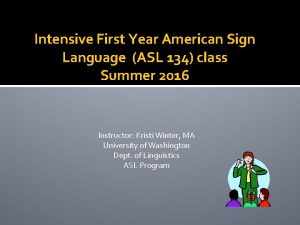Intensive First Year American Sign Language ASL 134





























































- Slides: 61

Intensive First Year American Sign Language (ASL 134) class Summer Quarter Instructor: Kristi Winter, MA University of Washington Dept. of Linguistics ASL Program

Agenda: � Today: � SN Unit 1 Homework Assignment 1: : 1 due (pp. 4 -5) � Signing Lunch at HUB, near Starbucks (12: 45 – 1: 30 pm) � � We will meet other ASL students and teachers from different sections Remember to turn off voice! � Thursday: � � � SN Unit 1 Watch video of “Intro to Deaf Community” and “Deaf President Now”. Sample Video Assignment due (see Canvas for information on this assignment) � Monday, June 25 th � � Quiz #1 (ASL Facts & History, Unit 1 and Syllabus) SN Unit 2

Monday’s Quiz �Read “Deaf Awareness Quiz”, syllabus, ASL Facts and History (read pages v-ix and xiv of student’s workbook), Power. Point slides (Canvas’ Pages). �Unit 1 �Cardinal Numbers 1 -10 �Color signs �Fingerspelling names (Fist Letters)

Review Survival Signs BREAK EMAIL QUIZ, TEST, or EXAM RIGHT or CORRECT WRONG STOP GO AHEAD or PROCEED 8. GIVE-TO 9. SORRY 1. 2. 3. 4. 5. 6. 7.

Review: ASL Signs (not in S. N. book) 1. 2. 3. 4. 5. 6. 7. MEANING NICE TO MEET YOU SUNDAY MONDAY TUESDAY WEDNESDAY THURSDAY 1. 2. 3. 4. 5. 6. FRIDAY SATURDAY WEEKEND HARD EASY

Review: Cardinal Numbers 11 -15

11 12 13 14 15

Review: How Many? �ASL Structure: �_____HOW MANY?

Homework 1: 1 �Strategies for learning ASL 1. Build a language community. 2. Minimize reliance on English as you listen or converse in ASL. 3. Focus on meaning rather than individual signs. 4. Focus on the signer’s face, not on the hands for two very important reasons. 1. 2. you must see both the facial expression and what is signed it is considered rude to look away from the signers’ face while they are signing to you. 5. Show you understand the signer

Homework 1: 2 (pg. 7) �Circle the Number 1. 6 2. 7 3. 9 4. 8 5. 3 6. 8 (Answers on page 397) �Write the Number 1. 3 2. 5 3. 9 4. 2 5. 8 6. 4 7. 10 8. 1 9. 8 10. 7 (Answers are given in class)

Homework 1: 3 (pg. 13) �Circle the Letter 1. as 2. so 3. st 4. ni 5. si 6. ai 7. en 8. ta 9. os 10. oa (Answers on page 397) �Circle the Letter 2 1. ao 2. se 3. sm 4. ti 5. mi 6. ei 7. on 8. oa 9. os 10. ea (Answers are given in class)

Homework 1: 3 �Reading Fingerspelling (see p. 10) �Reading someone’s fingerspelling is not easy. It takes time to develop the skill. Everyone approaches fingerspelling differently. But all agree that it takes practice, and more practice. �Here a few suggestions: �work on recognizing the shape and the movement of letters and letter combinations

Homework 1: 3 �Here a few suggestions: �work on catching the first and last letters of the word and use context (what is being discussed) to help you guess the word spelled. �don’t be timid. Ask the person to spell the word again and again – until you understand the word.

Homework 1: 4 �Andrew Foster �He spent his life dedicated to improving education for Deaf people. A teacher, pioneer, and missionary, his legacy lives on in the many schools he opened in West Africa. (pages 14 -15) �https: //www. youtube. com/watch? v=ij 3 d-Gjq. Ty. A

Review: Pronouns �Using the index finger to point at person(s) or object(s). It’s called Deixis (Linguistics term for “pointing at”) 1. 2. 3. 4. 5. 6. I AM/ME YOU ARE HE, SHE, IT IS WE ARE, US YOU ARE (plural) THEY ARE

Review: Vocabulary for WH-Word Questions 1. 2. 3. 4. 5. 6. WHO WHAT WHERE WHY WHEN HOW

Review: Introducing Oneself with Wh-Word Questions �Signer A: Greet, give name, and then ask for name �Signer B: Give name �A & B: Express pleasure in meeting �Be sure you : �furrow brows together and lean head forward to indicate a wh-word question. �use correct hand position to spell name �use correct orientation for the sign phrase NICE TO MEET YOU

ASL Signs 1. 2. 3. 4. 5. 6. 7. 8. 9. SAME-AS DIFFERENT SHAPE LETTER NUMBER AGAIN HOMEWORK MEANING ERROR 1. 2. 3. 4. 5. REMEMBER FORGOT NICE TO MEET YOU FINGERSPELLING COPY-ME

Homework 1. 5 (pg 18) �Answers are on page 398

Homework 1. 5 (p. 20) �List your classmates names in your book (see p. 20)

Classroom Exercise (Not in SN workbook) � Eye contact. What similarity do you see in the signs eye contact, look at me, and no eye contact? What do you think it means? � Hold on. Practice using the hold on sign with your teacher or a classmate. What is a polite way of signing hold on? What about a rude or impolite way?

Homework 1: 6 (pg. 22) � Circle the Number (Answers are on page 398) � Write the Number (Answers are given in class) 1. 3 2. 5 3. 11 4. 2 5. 14 6. 8 7. 9 8. 12 9. 6 10. 4 11. 10 12. 15 13. 13 14. 1 15. 7

Homework 1: 7 Ways of Communicating With Others (p. 23) 1. 2. 3. 4. 5. Signing Gestures Writing or typing Third person Lipreading and speech �Let the Deaf person know you sign �Avoid spoken English or using voice with out relaying information in ASL �Let the Deaf person set the communication mode

Lesson 1: 7 Same or Different 2

Same or Different II �Review: 1. LETTER 2. NUMBER 3. NAME 4. SHAPE

Make up a pair for each category: shapes, numbers, letters, and names. For example: • Shapes • Numbers 6 9 • Letters ao es • Names Mary

Conversation Practice �Watch video of Unit 1 Conversation �Conversation Practice: �Find a partner and role play the situations below. �Situation 1: � You are responsible for getting the correct spelling of the names about to be printed on a program. Check the spelling of your partner’s name, but when you ask, spell the name with one incorrect letter.

Conversation Practice �Watch video of Unit 1 Conversation �Conversation Practice: �Find a partner and role play the situations below. �Situation 2: � You meet a friend you haven’t seen in five years, but you are not sure of the person’s name.

Where all the “little” words like is, to, and are? �ASL is not English, neither are Japanese, Spanish and Latin. �ASL does not need separate “little” words, they are already included in each ASL sign. �E. g. THANK YOU (one ASL sign) �English required two words (verb –”to thank” and object –”you” �You need to learn how language is structured, not wondering why it isn’t like your own spoken language.

Classroom Exercise �Little words. Sign each phrase or sentence in ASL. 1. 2. 3. 4. 5. She is happy. My name is ____. He wants to learn ASL. They are busy We are____.

Vocabulary: Introductions 1. 2. 3. 4. 5. 6. 7. 8. 9. Deaf Friend Hard of hearing Hearing To introduce To meet Meeting My Nice 1. Nice to meet you 2. To want

Dialogue 1. 2. 3. 4. Signer A: Hi! How are you? Signer B: I’m fine. How are you? Signer A: I’m good. I’m _______. I’m Deaf Signer B: Hi, my name is ______. I’m hearing. FYI – Use deixis (pointing at) instead of the sign MY when signing “My name is…”

Identifying Gender

Basic Color

Basic Color �Which handshapes are initialized?

Basic Clothing and Appearance

© 2007, Jason E. Zinza. All Rights Reserved. Unauthorized duplication prohibited. 37

© 2007, Jason E. Zinza. All Rights Reserved. Unauthorized duplication prohibited. 38

© 2007, Jason E. Zinza. All Rights Reserved. Unauthorized duplication prohibited. 39

Breakaway �Game �Sign your number and someone else’s number. The person with the second number signs their number and someone else’s number, and so on.

The Classroom

Identifying Basic Clothing and Hair Signer A: Spell a name, ask whose name it is B: Identify who (raise brows): • gender • brief description • point out and glance A: Glance and nod B: Affirm (nod)

Lesson 1: 8 Asking Who Look at each student and see if you know their name. If you are not sure, ask that person.

Signer A: Spell a name, ask whose name it is B: Identify who (raise brows): • gender • brief description • point out and glance A: Glance and nod B: Affirm (nod)

Did You Realize? The hands on the statue of Abraham Lincoln at the Lincoln Memorial in Washington DC appear to spell out the initials A and L. Legend has it that Daniel Chester French, the famed sculptor, was influenced by his earlier bronze sculpture found on the Gallaudet University campus of Thomas Hopkins Gallaudet teaching a Deaf girl whose hand is forming the letter of her first name, Alice.


Deaf Cultural Behaviors �Getting Attention: �Handwave �Shoulder Tap

Deaf Cultural Behaviors �Voices � Using your voice to talk to another hearing individual instead of signing when a Deaf person is near is considered rude. Develop the habit of always signing when you know a Deaf person is in the same room with you. This way, everybody has equal access to what is being communicated. � If you must speak to a hearing person who doesn’t know ASL, then tell your Deaf friend or teacher that first, before speaking. You may be surprised to learn that most Deaf people know when hearing people are talking, even if someone is whispering. How so? Remember, Deaf people rely on their vision far more than hearing people do! Your teacher may remind you to turn off voice if you’re being rude in class. � Zinza, Jason E. (2006) Master ASL! Sign Media, Inc. Burtonsville, MD

Grammar Notes �Yes/No Questions in ASL �an expression that shows you are asking a yes/no question. �Keep the eyebrows raised until you’ve completed signing the question. �Examples � I’m going to the bathroom. � Am I going to the bathroom?

Grammar Notes �Yes/No Questions in ASL 1. Are you learning ASL? 2. Are you hearing? 3. Do you want to learn ASL? 4. Do you want to meet my friend?

Grammar Notes �Yes/No Questions in ASL � Work with a partner and ask him/her each question. Your partner will respond according to the information in bold. Switch roles and repeat. 1. 2. 3. 4. 5. Is he/she paying attention? (Yes, he/she is paying attention) Are you sick? (No, I’m fine. ) Do they want to learn ASL? (Yes, they want to learn ASL) Are you sleepy? (Yes, I am sleepy) Are you Deaf? (No, I am hearing)

Facial Expressions & Non-Manual Signals �Non-Manual Signals (NMS) are the various parts to a sign that are not signed on the hands. �NMS or Facial Expressions - convey your tone of “voice” while you sign. Your facial expressions should match the meaning and content of what you’re signing so if you’re signing I am happy, then look happy! � Zinza, Jason E. (2006) Master ASL! Sign Media, Inc. Burtonsville, MD.

Using Non-Manual Signals (NMS) �Sign YES NMS-head nod �Sign NO NMS-head shake �Using the correct NMS while signing each sentence in ASL: 1. I’m not Deaf. I’m hearing. 2. Yes, I’m learning how to sign. 3. I didn’t go to the bathroom. 4. They aren’t sick. 5. We’re not busy. **You don’t need a separate sign for don’t or not. Just use the head shake while signing the sentence.

Classroom Exercise �Use the correct sign with various facial expressions to show the difference between each meaning. 1. 2. 3. 4. 5. I’m not afraid…. terrified. I’m not busy…. . overwhelmed. I’m not bored…. . incredibly bored. I’m not sick…. . deathly ill. I’m not stressed…. . stressed out.

How important is fingerspelling? �Fingerspelling is used for: 1. first, last, and middle names 2. names of places (cities, states, stores) 3. titles of movies and books 4. certain foods 5. for clarification when one sign has several meanings 1. Example: COUNTY/COUNTRY 6. technical terms

What if I make a mistake while fingerspelling?

3 Letter Names Rob Ona Ian Aga 2. Rea Ana Mia Tia 3. Gus Abe Wes Sue 4. Ken Kim Ned Kia Fae Eve Sue Ace 1.

Fingerspelling practice for quiz. �I will fingerspell at “normal speed” which is the average speed of Deaf people. �Hint: Only the selected names from this slides and workbook will be on the quiz. No new names. �Practice all you can with speed fingerspelling and reading fingerspelling. This is why study group and practice partners are so important to your ASL skills development.

Homework 1: 4 �Andrew Foster �He spent his life dedicated to improving education for Deaf people. A teacher, pioneer, and missionary, his legacy lives on in the many schools he opened in West Africa. (pages 14 -15) �https: //www. youtube. com/watch? v=ij 3 d-Gjq. Ty. A

What’s for Homework? �Practice fingerspelling your first and last name until you become comfortable spelling quickly and clearly. Watch the video for examples of fingerspelling. �Homework assignments for Thursday: �Do Homework 1: 7 -1: 8. Bring a hard copy of Homework 1: 7 (pp. 23 -24), and 1: 8 (pp. 25 -27). Do all of them. Typed and printed. Look for the ones that said “Answers are given in class” in your Signing Naturally workbook. I will show you the answers in class for you to correct your homework and then submit it to me for full points. �* Bring your workbook to class everyday. We will do some classroom exercises from this workbook.

Sources: �Smith, C. , Lentz, E. & Mikos, K. (1988)Signing Naturally Student Workbook Level 1. Dawn. Sign. Press. San Diego, CA �Smith, C. , Lentz, E. , Mikos, K. (2008) Signing Naturally Units 1 -6. Dawn Sign Press. San Diego, CA. �Zinza, Jason E. (2006) Master ASL! Sign Media, Inc. Burtonsville, MD. �Eastman, G. (1989) From Mime to Sign. T. J. Publishers, Inc. Silver Spring, MD. �Pictures from Microsoft Clip Arts
 No talking sign
No talking sign Signs signs everywhere signs meaning
Signs signs everywhere signs meaning Eyes in sign language
Eyes in sign language Names and tidbits signing naturally answers
Names and tidbits signing naturally answers What are the five parameters of a sign
What are the five parameters of a sign Portuguese sign language alphabet
Portuguese sign language alphabet Asl sign for gospel
Asl sign for gospel Asl sign for sport
Asl sign for sport Asl unit 5
Asl unit 5 Examples of palm orientation in asl
Examples of palm orientation in asl Soda machine in asl
Soda machine in asl Trousseau's
Trousseau's What is trousseau sign
What is trousseau sign Hypermagnesemia causes
Hypermagnesemia causes Aseptic meningitis,
Aseptic meningitis, Negative times a positive
Negative times a positive Easter triduum colours and symbols
Easter triduum colours and symbols Leaver poem
Leaver poem Difference of first language and second language
Difference of first language and second language Difference of first language and second language
Difference of first language and second language Trima kasih ya tuhanku
Trima kasih ya tuhanku Hbu118
Hbu118 Stat 134 berkeley
Stat 134 berkeley Art 134 ctb
Art 134 ctb Commonwealth act no 80
Commonwealth act no 80 A sample of neon gas occupies a volume of 677 ml at 134 kpa
A sample of neon gas occupies a volume of 677 ml at 134 kpa Petrarch sonnet 134
Petrarch sonnet 134 1910 134
1910 134 Stats 134
Stats 134 Econ 134
Econ 134 Hasil dari 108 + 132 - 134 adalah
Hasil dari 108 + 132 - 134 adalah 1910 134
1910 134 Salmo 120 121
Salmo 120 121 Osha 1910 respiratory protection
Osha 1910 respiratory protection Optisanitas calle 134
Optisanitas calle 134 1910 134
1910 134 Osha 29cfr1910.134
Osha 29cfr1910.134 1910 134
1910 134 Salmo 128
Salmo 128 Stat 134
Stat 134 Stat 134
Stat 134 134/141
134/141 Stat 134 berkeley
Stat 134 berkeley Stat 134 berkeley
Stat 134 berkeley Stat 134 berkeley
Stat 134 berkeley Berkeley stat 134
Berkeley stat 134 Osha hazard communication standard 29 cfr 1910
Osha hazard communication standard 29 cfr 1910 Fenofibrate manufacturer coupons
Fenofibrate manufacturer coupons Econ 134
Econ 134 Econ 134
Econ 134 Puberache
Puberache First sign of puberty in males
First sign of puberty in males First law of thermodynamics sign convention
First law of thermodynamics sign convention Puberty age
Puberty age First year seminar
First year seminar Chapter 9 intellectual development in the first year
Chapter 9 intellectual development in the first year What is abib month
What is abib month Policy statement example mun
Policy statement example mun First year seminar
First year seminar First meeting of the year
First meeting of the year The first olympic games
The first olympic games Explain articles
Explain articles
